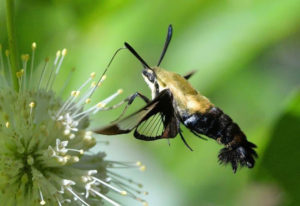By: Ashlyn Halseth
Beating their wings up to 70 beats per second and consuming nectar all day, it is no shock that the Hummingbird Moth is commonly mistaken for being a part of the avian group, Hummingbirds. Hummingbird Moths are in the family Sphingidae, which encompasses over 124 species of heavy-bodied moths with long front wings in North America alone. Five of those species are all grouped under the common name, Hummingbird Moth, with the

Clearwing Moth photograph by Hank Ohme
genus Hemaris: Sphinx Moth (H. aethra), Snowberry Clearwing (H. diffinis), Slender Clearwing (H. gracilis), Hummingbird Moth (H. thetis), and Hummingbird Clearwing (H. thysbe). Unlike most moths, which are nocturnal, Hummingbird Moths only feed upon nectar-rich plants during the day, giving meaning to their assigned genus, Hemaris, which comes from the Greek word hemera (ημερα), meaning day. While the reasoning for their common name is a little more obvious, the evolutionary advantages are very interesting!
This phenomenon is called convergence evolution, which occurs when two species that are not closely related taxonomically (or monophyletic) develop similar traits to one another to both adapt and thrive within the same environment. For example, this is why both the moths and birds have very similar wing structure and drink nectar from flowers. Here, both species can specialize within their taxonomic class to a prey source that is relatively untouched by other species and plentiful; thus, creating both a nectar-consuming group within the class Insecta and the class Aves. Therefore, both Hummingbird Moths and Hummingbirds developed soft, curled proboscises to drink nectar easily, as well as long and quick wings that stabilize their body long enough to drink plenty of nectar. Another theory to why these two species look so similar is because of another phenomenon called mimicry. Because the number one predator of moths is birds, it is beneficial to the Hummingbird Moths to look similar to their attackers; this takes the phrase “keep your friends close, and your enemies closer” to the next level, because the Hummingbird Moth keeps birds so close, they almost becoming them!
In the field, it may be hard to truly distinguish these two apart, but one quick tip is two count their wings. Hummingbirds will only have one set, while Hummingbird Moths will have one large set, and a smaller set closely behind. Also, if you are able to get a really close look, Hummingbird Moths will have two small antennae, while Hummingbirds will only have a crest on a few certain species. As for their lifecycle, Hummingbirds can live up to 5-8 years, while the Hummingbird Moth can only live up to 7 months, with some species as short as 3-5 weeks! However, the Hummingbird Moth does have the advantage of going through a metamorphosis. Twice a year, a female moth will lay a brood of 200 eggs, each ready to hatch in only 6-8 days. Then they will spend their 3 weeks as caterpillars eating a variety of plants (Epilobium, Stellaria, Centranthus, Rubiaceaethers, madders, bedstraw). Once big enough to pupate, they will quickly build their cocoon near the base of the plant or even in the surrounding leaf litter to camouflage away from predators. After a short couple of weeks, typically in mid-to-late summer, the moths will emerge, ready to pollinate plants various families, Apocynaceae, Caprifoliaceae, Ericaceae, Rosaceae. For a more in-depth explanation of the Hummingbird Moth’s lifecycle, please click here!
Sources:
Hummingbird Moth Facts. Hummingbird Plus. Accessed July 23, 2020. https://www.hummingbirdsplus.org/hummingbird-moth-facts/
Life Cycle of Hummingbird Hawk Moth. Best Survivors on Earth. Video. Accessed July 23, 2020. https://www.youtube.com/watch?v=XM-xQt1JpqI
Genus Hemaris. BugGuide. Accessed July 23, 2020. https://bugguide.net/node/view/2637/bgpage
Hummingbird Moth (Hemaris spp.). US Forest Service. Accessed July 23, 2020. https://www.fs.fed.us/wildflowers/pollinators/pollinator-of-the-month/hummingbird_moth.shtml
Hummingbird Moth (Clearwing Moth). Mass Audubon. Accessed July 23, 2020. https://www.farmersalmanac.com/hummingbird-moth-32556#:~:text=The%20hummingbird%20moth%20can%20be,its%20host%20bush%20or%20vine.
Have You Seen A Hummingbird Moth? Here Are 10 Fascinating Facts. Farmers Almanac. Accessed July 23, 2020. https://www.farmersalmanac.com/hummingbird-moth-32556#:~:text=The%20hummingbird%20moth%20can%20be,its%20host%20bush%20or%20vine.
Covergent Evolution. Science Daily. Accessed July 23, 2020. https://www.sciencedaily.com/terms/convergent_evolution.htm#:~:text=In%20evolutionary%20biology%2C%20convergent%20evolution,similar%20environments%20or%20ecological%20niches.

Recent Comments